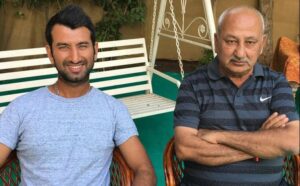
Atreyo Mukhopadhyay
Khanderi is almost a godforsaken place on the Rajkot-Jamnagar Highway. It’s about 20 kms from the heart of Rajkot. Until a few years ago, it was difficult to get there due to lack of commute options.
The place became famous after the Saurashtra Cricket Stadium came up there — a giant structure in the middle of nowhere. Now, of course, it’s called the Niranjan Shah Stadium. On international match days, the place comes alive and lies forlorn for the rest of the year.
That is not the story. Beyond that stadium, in a place called Taragadi, further down the highway was a cricket academy run by Arvind Pujara. In the days when there was no transport, he used to ferry the students in a rented vehicle and take them for practice. If around, his son would join them. It was not and still is not common to see an India star persevere his way to perfection unnoticed and untroubled.

The background mattered
That, in a way, is Cheteshwar Pujara, a small-town boy from a humble family who remained a simpleton after achieving fame, money and success playing for India. He could have afforded better facilities in Rajkot. But he chose to grind it out in the background. He preferred to stay rooted when he could have been a little more extravagant.
One saw Pujara stay unmoved at the crease against all sorts of bowling in almost every country he played in. Nothing flustered him. Not just opponent bowlers, even adverse comments from his own teammates on slow strike-rate could affect his steadfastness to stick to his principles. Somewhere down the line, it seems that those years of toil with nobody watching made him that. He wouldn’t confront adversity with bravado, but with quiet determination.
The father’s contribution
His father played a big role in this. Arvind played six Ranji Trophy matches and was not in the good books of the Saurashtra cricket administration for some of his views. The family plunged into crisis when his wife Reema succumbed to cancer. Cheteshwar was 17 and this tragedy shattered him. He was an upcoming star, but losing his mother took him close to quitting the game.
Arvind once told this correspondent that their family spiritualist or Guruji played a part in bringing his son back to cricket. It was not an easy restart. The teenager found it difficult to focus and scored a few ducks in the first few games he played. However, it wasn’t long that he was back to his heavy-scoring ways.
Arvind is conventional when it comes to cricket. He was Cheteshwar’s coach for quite some time and instilled in him the values of batting that made him famous in world cricket. Like his son, Arvind often regretted that not being part of an IPL franchise was robbing him of the chance to practise against good bowlers. Cheteshwar was seen only when India were playing Test matches.
The struggle he welcomed to be in shape for a Test call-up and deliver instantly is the Pujara story. He went to England and ground it out in the County Championship. When at home, he travelled to Taragadi to train at the academy. In the Australia tour of 2017-18 where he made three centuries, a half-cut-half-slash off Mitchell Starc went for six and surprised everyone. That was uncharacteristic. Arvind had revealed that he prepared for these shots at the academy, keeping in mind the bouncy pitches.
To be sidelined for about nine months and then make a smiling comeback year after year is not easy. Pujara succeeded in this difficult test because he never forgot his roots, as in the foundation of his game. To strengthen that, he was prepared to travel any distance — even to that academy in the Rajkot summer heat. He had the luxury of staying at home and enjoying the good things in life, but he chose the hard way.
Now that he has taken to commentary, Pujara will surely be seen and heard more often than his playing days. His father should be happy about that. Those Taragadi trips have paid off.
Follow Revsportz for latest sports news





